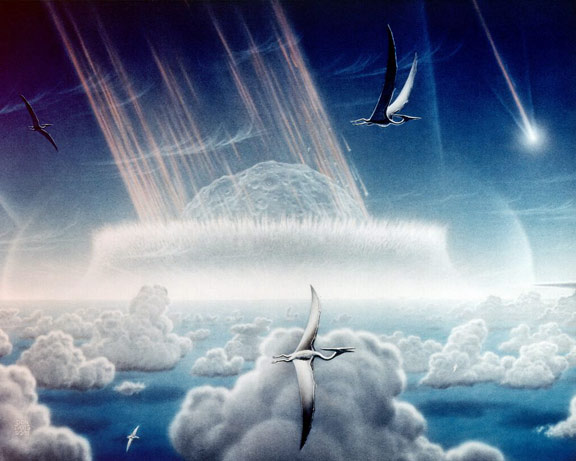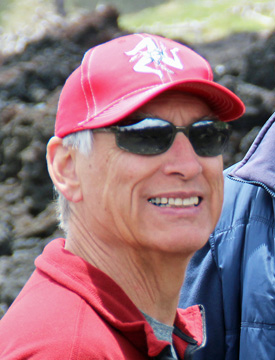|
Asteroids have struck Earth continuously since it formed 4.5 billion years ago. Their sizes range from infinitesimal to immense, with vast numbers of the former and few of the latter. In the 1m-wide range, about 37 asteroids strike Earth daily.
The famous Cretaceous–Paleogene (“K-T”) extinction event occurred 66,043,000 years ago (give or take 11,000 years, according to radioisotope dating). About 75% of all animal and plant species ceased to exist. Individual mortality rates were certainly much higher — a species might avoid extinction even if 99% of its members die. All the dinosaurs perished, except birds.

The first to attribute the K-T event to an asteroid were high-energy physicist Luis Alvarez and his geologist son Walter.
NASA’s Donald Davis made this imaginative rendering.
Scientists now generally agree a 12 km (8 mile) space rock triggered the K-T event by striking Mexico’s Yucatan peninsula, releasing hundreds of millions of megatons of TNT of energy. The impact site became the 180-km-wide Chicxulub crater, while impact ejecta are found worldwide in a thin sedimentary layer, with iridium concentrations up to 1000 times normal levels.
To better appreciate the devastation these impacts cause, the atomic bomb that destroyed Hiroshima released 15,000 tons of TNT of energy, which I will denote 1 H. The energy released by an asteroid impact depends on many factors, but is proportional to the cube of its width, with a 5m (17-foot) asteroid releasing 1H.
In a 2013 wake-up call, a 17m asteroid exploded some distance from Chelyabinsk, Russia with energy 33 H, injuring over 1000 people.
Only humans can hope to prevent another catastrophic asteroid impact, and thereby save all Earth’s creatures, including us.
Congress gave NASA the goal (but no extra funding) of locating 90% of all Near Earth Asteroids (NEAs) wider that 140m (20,000 H). Clearly, we should try to find much smaller asteroids as well.
NEAs have elliptical orbits that cross Earth’s orbit. They are generally much farther from, but sometimes slightly closer to, the Sun than we are. For an NEA to hit Earth, both bodies must be at the orbital crossing point at nearly the same time — within ±3.5 minutes. That’s how long it takes Earth to move one Earth radius.
To avoid the fate of the dinosaurs, we must:
(1) Find all “large” NEAs.
(2) Measure the orbit of each NEA.
(3) Determine which NEA will hit Earth.
(4) Change those colliders’ orbits.
Since NEAs larger than 1km are easy to see, astronomers believe they have already found virtually all of them. None of those are on a collision course with Earth, at least for next 200 years. By then our technologies will surely improve.
How about smaller NEAs?
Our detection technologies are improving (see below). For a nominal distance and surface reflectivity, the smallest detectable NEA (and its impact energy) were: 3500m (333 million H) in 1980; 140m (20,000 H) in 2013; and 60m (1300 H) in 2018.

Astronomers have observed 18,500 NEAs so far. But some of these may be duplicates. Only a small fraction of observed NEAs have well-known orbits, so we cannot always be sure a “new” NEA hasn’t already been counted.
According to CNEOS, NASA’s official database maintained by JPL/Caltech, the closest approaches in the next 200 years of any known NEA with well-measured orbits are: 450m (7 million H) Apophis coming within 6 Earth radii on April 13, 2029, and two 10m asteroids in 2050 and 2095.
But, what about currently unseen NEAs, or NEAs without known orbits?
JPL/Caltech scientists Shao, Zhou, Turyshev, Zhai, Saini, and Trahan say our current efforts — using telescopes on Earth or in low-Earth-orbit — may take another 15 to 20 years to find 90% of NEAs over 140m, and “many decades” to find 90% of NEAs down to 60m. Also, they claim less than 10% of known NEAs have well-measured sizes, orbits, and compositions, all of which we must know to devise effective defenses. Properly characterizing these NEAs could take over 100 years at the current rate.
They propose launching 8 small space telescopes that could detect and catalog 90% of NEAs over 140m in 3 years of operation. By catalog, they mean measuring an orbit well enough to uniquely identify it even a few decades later.
They claim their new technique — synthetic tracking (sketched below) — is more than 10 times as effective in finding NEAs.

Near-Earth telescopes can’t see anything that occurs near or behind the Sun. But an array of telescopes spaced along Earth’s orbit can track asteroids zipping past the Sun, where their orbits are most precisely measurable.
More space telescopes would decrease the search time, while larger ones would detect even smaller NEAs.
The JPL plan provides a clear path to steps (1), (2) and (3). That leaves only one “small detail”: step (4) what can we do about an NEA heading our way?
Experts debate how best to alter an impactor’s trajectory: we should push some and pull others. But, the essential requirement for survival is time. We must know of an impending collision many years, if not decades, before doomsday.
Let’s consider a hypothetical asteroid with a 3.3-year orbital period that is on a course to strike Earth dead-center. If 10 years before that collision, we change its velocity by only 4 mm/s (0.1 mph), the asteroid will miss us. The required velocity change varies substantially with the asteroid’s position along its orbit — we must be able to wait and strike at the optimal time.
If we are smart, we can save ourselves, and the birds and the bees.

Best Regards,
Robert
Feb 2019
Note: Previous newsletters can be found on my website.
|